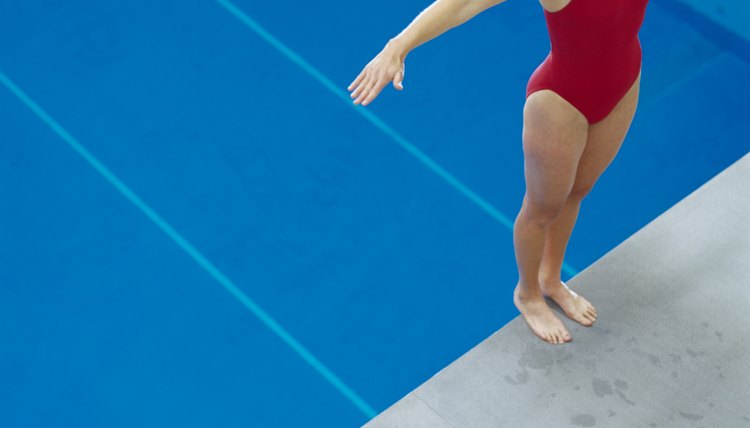Types of Swimming Dives

Swimming was the second most popular sport in the United States in 2008, according to the Census Bureau. Diving into the water is as much fun as swimming, especially when you know how to do the different types of dives. Discerning the various types seems difficult to the untrained eye with the divers twisting and turning quickly before splashing into the water. Breaking each dive into simple elements not only makes performing each dive easier but also enhances your experience while you watch other people dive.
Groups
Swimmers use one of six group types of dives to enter the water. These groups are forward, backward, reverse, inward, twisting and arm-stand. The forward, backward, reverse and inward groups describe how you rotate your body through the dive in relation to the diving board and your starting position. The twisting group describes any type of dive incorporating a twist. Divers perform arm-stand dives in a handstand at the edge of the board. Divers do not use a springboard for this position.
Forward and Backward Groups
Perform a dive from the forward group by standing at the edge of the platform or springboard, facing the water, and diving straight in or adding a somersault. Begin a backward dive with your back to the water. When you perform somersaulting dives from the forward or backward groups, rotate your body away from the board and toward the water.
Reverse and Inward Groups
A dive from the reverse group is similar to the forward group, except that your body rotates toward the board instead of away from it. Begin an inward dive with your back to the water and rotate your body toward the board and away from the water. Swimmers once called these special dives “gainers” and “cutaways,” respectively.
Twisting and Arm-stand Groups
There are four types of dives included in the twisting group. Begin these dives in any position except a handstand, and incorporate a forward, backward, reverse or inward twist into the dive. The arm-stand group includes all dives beginning in the handstand position, regardless of what you do during the rest of the dive.
Body Positions
In addition to the six groups of dives, you may incorporate different body positions into the dive. A pike describes your position during a dive in which your legs are straight and you are bent at the hips. Dive in a straight position by keeping your knees and hips unbent. Assume a tuck position by bending your hips and knees, drawing your knees close to your chest and your heels close to your buttocks. Free diving incorporates one or more of these body positions into a twisting dive.
Combined Elements
Swimmers may dive from a springboard or a platform. You may incorporate various positions into basic dive groups to create new elements. For example, you can perform a reverse dive in a pike position by standing at the edge of the board, facing the water. Spring from the board, rotate towards the board while bending your hips and keeping your legs straight. Straighten your body just before you enter the water.
Writer Bio
Lynn Hetzler has been a writer since 2000. She was editor in chief and head writer for the online publication Eye on Cameraware. She owns a computer store offering repair, websites, instruction, and more. Hetzler is a certified medical assistant with experience in oncology, laboratory testing and protocol writing.
